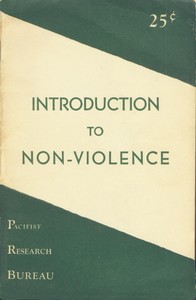Introduction to Non-Violence by Theodore Paullin
"Introduction to Non-Violence" by Theodore Paullin is a scholarly work written in the mid-20th century. It examines the principles and applications of non-violent action, focusing on its historical contexts and theoretical underpinnings within pacifism. The text likely aims to delineate various non-violent strategies, explore their effectiveness, and engage in a critical discussion regarding the definitions and classifications associated with non-violence, thereby offering insights applicable to contemporary social issues. The opening of the
work introduces the context of the pacifist movement during World War II, emphasizing the significance of unity among diverse individuals against war. Paullin explores the confusing and sometimes contradictory terminology used in pacifist discourse and distinguishes between different interpretations and applications of non-violence. He sets the stage for a deeper analysis of non-violent techniques, including examples from history, while acknowledging the philosophical debates concerning the morality and practical implications of these methods. Initially, he lays a foundational understanding of the term “pacifism” itself, indicating that many within the movement may not share a cohesive definition or approach, which sets the groundwork for the discussions in subsequent chapters. (This is an automatically generated summary.)
Read or download for free
| How to read | Url | Size | |||
|---|---|---|---|---|---|
| Read now! | https://www.gutenberg.org/ebooks/18493.html.images | 235 kB | |||
| EPUB3 (E-readers incl. Send-to-Kindle) | https://www.gutenberg.org/ebooks/18493.epub3.images | 180 kB | |||
| EPUB (older E-readers) | https://www.gutenberg.org/ebooks/18493.epub.images | 182 kB | |||
| EPUB (no images, older E-readers) | https://www.gutenberg.org/ebooks/18493.epub.noimages | 133 kB | |||
| Kindle | https://www.gutenberg.org/ebooks/18493.kf8.images | 286 kB | |||
| older Kindles | https://www.gutenberg.org/ebooks/18493.kindle.images | 234 kB | |||
| Plain Text UTF-8 | https://www.gutenberg.org/ebooks/18493.txt.utf-8 | 186 kB | |||
| Download HTML (zip) | https://www.gutenberg.org/cache/epub/18493/pg18493-h.zip | 166 kB | |||
| There may be more files related to this item. | |||||
Similar Books
About this eBook
| Author | Paullin, Theodore |
|---|---|
| Title | Introduction to Non-Violence |
| Credits |
Produced by Mark C. Orton, Martin Pettit and the Online Distributed Proofreading Team at http://www.pgdp.net |
| Reading Level | Reading ease score: 47.6 (College-level). Difficult to read. |
| Language | English |
| LoC Class | HM: Social sciences: Sociology |
| Subject | War |
| Subject | Passive resistance |
| Subject | Pacifism |
| Category | Text |
| EBook-No. | 18493 |
| Release Date | Jun 2, 2006 |
| Copyright Status | Public domain in the USA. |
| Downloads | 340 downloads in the last 30 days. |
| Project Gutenberg eBooks are always free! | |

